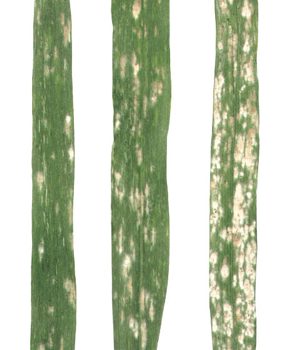Diseases
Blumeria graminis (DC). Speer f. sp. tritici Marchal - Powdery Mildew of Wheat.
Systematic position.
Division Ascomycota, order Erysiphales, family Erysiphaceae, genus Blumeria. Synonym: Erysiphe graminis DC. f. sp. tritici MarchalBiological group.
Diseases of grain crops.Morphology and biology.
Powdery mildew is usually found on the leaves, but the fungus may attack all aboveground parts of the plant. The scurf appears on stems, leaves, sheathes, and on ear, being white, web-like, later farinose, gradually turning in dense mycelial colonies of dirty grayish to brown, ochre, or rusty brown color. Mycelium surface, branched, septate. Appressoria papilliform, 3.5-7 . in diameter. Appressoria form haustoria, moving into plant cells. Conidiophores erect, single-celled, slightly elongated, 60-90 x 4-7 .. Conidia in chains (up to 10-20), single-celled, hyaline, ellipsoid to lemon-shaped, 20-45 x 8-20 .. Ascomata (cleistothecia) globose-depressed, 110-280 . in diameter; appendages few to numerous, in the lower half of the ascocarp, mostly scarcely developed, mycelioid, thin-walled, simple, rarely branched, usually shorter than cleistothecium diameter. Asci 6-30, stalked, 50-105 x 20-45., 4-8 spored. Spores ellipsoid-ovoid, 20-24 x 10-14 ., hyaline or faintly colored, yellowish, seldom developed. This fungus over-winters on winter shoots and volunteers as mycelium and conidia and as cleistothecia on debris (in districts of spring wheat cultivation). In the spring and summer the fungus develops conidia on winter wheat and later on spring wheat. From the stooling stage the fungus forms ascomata. From August until October there is a maturing and releasing of ascospores, which are inoculum for winter shoots and volunteers. In droughty districts (districts of spring wheat cultivation) asci and ascospores are formed slowly, and ripen only after wintering in the spring and serve as inoculum for wheat shoots.Ecology.
High air temperature (higher than 30.C) delays development of powdery mildew. Disease damages plants at temperature 0-20.C and relative air humidity 50-100%. Conidia germinate at air humidity 95-100% and temperature 3-31.C (optimum 14-17.C). Wet weather accelerates maturing and releasing of ascospores, while dry weather delays these processes.Distribution.
Europe, Asia, Africa, America, Australia. In Russia the disease is spread everywhere, but is especially harmful in the Northern Caucasus, Volga Basin, Central Chernozem, Ural, and Volga-Vyatka Regions. Also in Ukraine, Byelorussia, Baltic States and Transcaucasia.Economic significance.
The disease decreases area of assimilation surface of leaves and destroys chlorophyll. At high severity the stem numbers are reduced, earing lingers, but maturing accelerates. Crop losses can reach 10-15%, sometimes 30-35%. Control measures include a combination of land treatment, resistant cultivars, and application of fungicides during vegetation period.Reference citations:
Cherebedova M.A., Davidovich R.E., Grinberg Sh.M. 1980. The sources of wheat infection by powdery mildew in Moldavia. Izvestiya AN Moldavskoi SSR. Kishinev: Shtiintsa. V. 4: 74-75. (In Russian)Chumakov A.E., Minkevich I.I. 1969. Powdery mildew of wheat. In: Methods of territory long-term forecast of plant diseases. Leningrad: VIZR. 36-37 p. (In Russian)
Chumakov A.E., Minkevich I.I. 1971. Powdery mildew of wheat. In: Methods of territory long-term forecast of plant diseases. Leningrad: VIZR. 54-55 p. (In Russian)
Chumakov A.E., Naumova I.P., Zakharova T.Sh. 1980. Recommendation on cereal protection from rust and powdery mildew. Moscow: Kolos. 32 p. (In Russian)
Levashova G.I. 1994. Race and patotype structure of causal agent of wheat powdery mildew in the North Caucasus. Proceedings of Russian Academy of Agricultural Sciences. N. 1: 10-12. (In Russian)
Malyutina R. 1965. Powdery mildew of cereals and its control. Sel.skoe khozyaistvo Kirgizii, N. 9: 23-24. (In Russian)
Mzhavanadze A.V. 1970. To the study of powdery mildew in Georgia. Proceedings of Tbilisi Institute of Plant Protection. Tbilisi. N. 22: 205-209. (In Russian)
Nikulina N.K., Chumakov A.E. 1968. Powdery mildew of cereals. Zashchita rastenii, N. 8: 12. (In Russian)
Sanin S.S., Cherkashin V.I., Nazarova L.N., Sokolova E.A., Strizhekozin Ju.A., Ibragimov T.Z., Neklesa N.P. 2002. Phytosanitary expertise of cereal crops (plant diseases): Recommendations. Moscow: FGNU "Rosinformagrotech". 140 p. (In Russian)
Sanin S.S., Nazarova L.N., Sokolova E.A., Ibragimov T.Z. 1999. The health of cereal field. Zashchita i karantin rastenii, N. 2: 28-31. (In Russian)
Tursumbaev A. 1972. Powdery mildew of wheat on South-East of Kazakhstan. Zashchita rastenii, N. 5: 21. (In Russian)
© Ishkova T.I.


